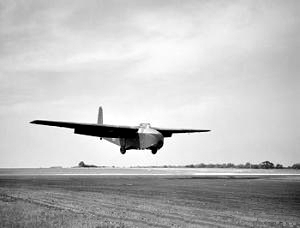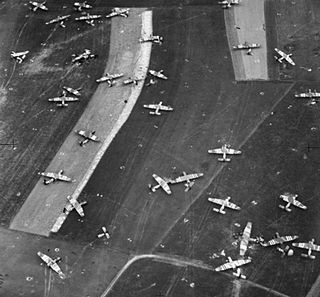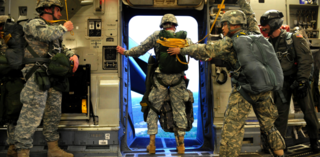Related Research Articles
Airborne radio relay is a technique employing aircraft fitted with radio relay stations for the purpose of increasing the range, flexibility, or physical security of communications systems. The aircraft may be manned or unmanned aerial vehicles.

The M22 Locust, officially Light Tank (Airborne), M22, was an American-designed airborne light tank which was produced during World War II. The Locust began development in 1941 after the British War Office requested that the American government design a purpose-built airborne light tank which could be transported by glider into battle to support British airborne forces. The War Office had originally selected the Light Tank Mark VII Tetrarch light tank for use by the airborne forces, but it had not been designed with that exact purpose in mind so the War Office believed that a purpose-built tank would be required to replace it. The United States Army Ordnance Department was asked to produce this replacement, which in turn selected Marmon-Herrington to design and build a prototype airborne tank in May 1941. The prototype was designated the Light Tank T9 (Airborne), and was designed so that it could be transported underneath a Douglas C-54 Skymaster transport aircraft, although its dimensions also allowed it to fit inside a General Aircraft Hamilcar glider.

The Boeing E-4 Advanced Airborne Command Post (AACP), the current "Nightwatch" aircraft, is a strategic command and control military aircraft operated by the United States Air Force (USAF). The E-4 series are specially modified from the Boeing 747-200B for the National Emergency Airborne Command Post (NEACP) program. The E-4 serves as a survivable mobile command post for the National Command Authority, namely the President of the United States, the Secretary of Defense, and successors. The four E-4Bs are operated by the 1st Airborne Command and Control Squadron of the 595th Command and Control Group located at Offutt Air Force Base, near Omaha, Nebraska. An E-4B when in action is denoted a "National Airborne Operations Center".

The Airspeed AS.51 Horsa was a British troop-carrying glider used during the Second World War. It was developed and manufactured by Airspeed Limited, alongside various subcontractors; the type was named after Horsa, the legendary 5th-century conqueror of southern Britain.
The Joint Electronics Type Designation System (JETDS), which was previously known as the Joint Army-Navy Nomenclature System and the Joint Communications-Electronics Nomenclature System, is a method developed by the U.S. War Department during World War II for assigning an unclassified designator to electronic equipment. In 1957, the JETDS was formalized in MIL-STD-196.

A field hospital is a temporary hospital or mobile medical unit that takes care of casualties on-site before they can be safely transported to more permanent facilities. This term was initially used in military medicine, but it has also been used to describe alternate care sites used in disasters and other emergency situations.

The Parachutist Badge, also commonly referred to as "Jump Wings" is a military badge of the United States Armed Forces. The United States Space Force and United States Coast Guard are the only branches that do not award the Parachutist Badge, but their members are authorized to receive the Parachutist Badges of other services in accordance with their prescribed requirements. The DoD military services are all awarded the same Basic Parachutist Badge. The U.S. Army and U.S. Air Force issue the same Senior and Master Parachutist Badges while the U.S. Navy and U.S. Marine Corps issue the Navy and Marine Corps Parachutist Badge to advanced parachutists. The majority of the services earn their Basic Parachutist Badge through the U.S. Army Airborne School.

The Light Tank Mk VII (A17), also known as the Tetrarch, was a British light tank produced by Vickers-Armstrongs in the late 1930s and used during the Second World War. The Tetrarch was the latest in the line of light tanks built by the company for the British Army. It improved upon its predecessor, the Light Tank Mk VIC, by introducing the extra firepower of a 2-pounder gun. The War Office ordered 70 tanks, an order that eventually increased to 220. Production was delayed by several factors and only 100 to 177 of the tanks were produced.

The General Aircraft Limited GAL. 49 Hamilcar or Hamilcar Mark I was a large British military glider produced during the Second World War, which was designed to carry heavy cargo, such as the Tetrarch or M22 Locust light tank. When the British airborne establishment was formed in 1940 by the order of Prime Minister Winston Churchill it was decided to develop a large glider which would be able to transport heavy equipment in support of airborne troops. General Aircraft Limited were chosen in January 1941 to develop this glider, which they designated the GAL. 49 'Hamilcar'. It was designed to transport a light tank or two Universal Carriers. A number of problems, which included vacillation by the War Office on the number of gliders it wanted and poor management by GAL, led to delays in the production of the Hamilcar and it was not until mid-1943 that the first production glider was assembled. These problems were only partially solved and production of the glider continued to be slow, hampered by difficulties in finding suitable locations to store and construct them once their parts were produced. A total of 344 Hamilcars had been built when production ended in 1946.

The United States Army Airborne School – widely known as Jump School – conducts the basic paratrooper training for the United States Armed Forces. It is operated by the 1st Battalion (Airborne), 507th Infantry, United States Army Infantry School, Fort Benning, Georgia. The Airborne School conducts the Basic Airborne Course, which is open to troops from all branches of the United States Department of Defense, Reserve Officer Training Corps, and allied military personnel.

The General Aircraft GAL.48 Hotspur was a military glider designed and built by the British company General Aircraft Ltd during World War II. When the British airborne establishment was formed in 1940 by order of Prime Minister Winston Churchill, it was decided that gliders would be used to transport airborne troops into battle. General Aircraft Ltd were given a contract by the Ministry of Aircraft Production in June 1940 to design and produce an initial glider for use by the airborne establishment, which resulted in the Hotspur.

U.S. MIL-STD-810 is a United States Military Standard that emphasizes tailoring an equipment's environmental design and test limits to the conditions that it will experience throughout its service life, and establishing chamber test methods that replicate the effects of environments on the equipment rather than imitating the environments themselves. Although prepared specifically for U.S. military applications, the standard is often applied for commercial products as well.

A launch control center (LCC), in the United States, is the main control facility for intercontinental ballistic missiles (ICBMs). A launch control center monitors and controls missile launch facilities. From a launch control center, the missile combat crew can monitor the complex, launch the missile, or relax in the living quarters. The LCC is designed to provide maximum protection for the missile combat crew and equipment vital to missile launch. Missile silos are common across the midwestern United States, and over 450 missiles remain in US Air Force (USAF) service.
ISO 14644 Standards were first formed from the US Federal Standard 209E Airborne Particulate Cleanliness Classes in Cleanrooms and Clean Zones. The need for a single standard for cleanroom classification and testing was long felt. After ANSI and IEST petitioned to ISO for new standards, the first document of ISO 14644 was published in 1999, ISO 14644-1.
Matthew Samuel Collier is a veteran, business executive, entrepreneur, and speaker. At 29, he was elected as the youngest big-city "strong" mayor in the United States when he served as the chief executive of his hometown of Flint, Michigan, from 1987 to 1991. Following his four-year stint as mayor, he served in executive roles with several technology companies.

Operation Mallard was the codename for an airborne forces operation, which was conducted by the British Army on 6 June 1944, as part of the Normandy landings during the Second World War.

The Infantry Branch is a branch of the United States Army first established in 1775.

The United States Army Jumpmaster School trains personnel in the skills necessary to jumpmaster a combat-equipped jump and the proper attaching, jumping, and releasing of combat and individual equipment while participating in an actual jump that is proficient in the duties and responsibilities of the Jumpmaster and Safety; procedures for rigging individual equipment containers and door bundles; personnel parachute components by their specific nomenclature and characteristics; procedures and standards required to conduct a JumpMaster Personnel Inspection (JMPI); the duties and responsibilities of the Drop Zone Safety Officer; the presentation of the Jumpmaster briefing and sustained airborne training (SAT); and the execution of the duties of a Jumpmaster and Safety from a USAF aircraft during a day/night combat equipment jump.
Roy K. Flint (1928–2016) was a brigadier general in the United States Army, dean of the academic board at the United States Military Academy, and a president of the Society for Military History.
References
- Flint, Keith (2006). Airborne Armour: Tetrarch, Locust, Hamilcar and the 6th Airborne Armoured Reconnaissance Regiment 1938-1950. Helion & Company Ltd. ISBN 1-874622-37-X.